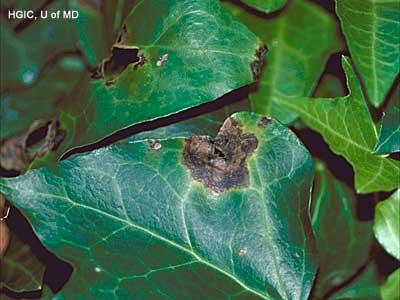***English ivy is a non-native invasive plant that spreads into managed landscapes and wild areas. We recommend that you consider removing and replace it with native or, at least, non-invasive plants.***
The symptoms of bacterial infection on English ivy include yellow-brown or black spots or blotches on the leaves. The spots may appear greasy or have a yellow ring or border around them. Initial leaf spots will usually be angular and confined between the leaf veins. Under cool wet conditions, the initial spots will run together and the entire leaf may become blighted and chlorotic, and covered with dark blotches. Infected leaves will usually wilt, die and drop off causing severe defoliation. Bacterial leaf spot and leaf blight can be caused by the bacteria Xanthomonas campestris p.v. hederae and Pseudomonas cichorii.
Management
Avoid overhead irrigation and thin plantings to increase air circulation that will promote faster leaf drying. Thinning can be accomplished by selective pruning of infected leaves or by mechanical removal such as with a lawn mower set at the highest setting. Removal of fallen debris and clean up of old leaves etc. will also help reduce the amount of moisture trapped and will promote faster drying of the planting bed.
